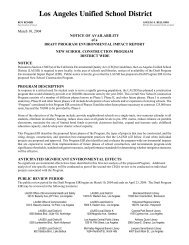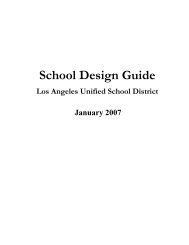Site-Specific Health and Safety Plan (HASP) - Laschools.org
Site-Specific Health and Safety Plan (HASP) - Laschools.org
Site-Specific Health and Safety Plan (HASP) - Laschools.org
Create successful ePaper yourself
Turn your PDF publications into a flip-book with our unique Google optimized e-Paper software.
LAUSD Proposed South Region High School #9 & Middle School #4<br />
6-5<br />
December 2006<br />
<strong>Site</strong> <strong>Specific</strong> <strong>Health</strong> & <strong>Safety</strong> <strong>Plan</strong> (<strong>HASP</strong>)<br />
1. Engineer/design to eliminate or minimize hazards. A major component of the design<br />
phase is to select appropriate safety features to eliminate a hazard <strong>and</strong> render it fail-safe<br />
or provide redundancy using backup components.<br />
2. Guard the hazard. Hazards that cannot be eliminated by design must be reduced to an<br />
acceptable risk level by safety guards or isolation devices that render them inactive.<br />
3. Provide warnings. Hazards that cannot be totally eliminated by design or guarding are<br />
controlled through using a warning or alarm device.<br />
4. Provide special procedures or training. When design, guarding, or warnings cannot<br />
eliminate hazards, subcontractors must develop procedures, training, <strong>and</strong> audits to ensure<br />
safe completion of work. Training cannot be a substitute for hazard elimination when<br />
life-threatening hazards are present. Decontamination procedures will consist of dry<br />
decon procedures including brushing off of truck tires <strong>and</strong> shoes of personnel in the<br />
exclusion/contamination reduction zones. No decon will be required of personnel in the<br />
support zone unless these personnel enter the exclusion/contamination reduction zone.<br />
5. Provide personal protective equipment. To protect workers from injury, the last<br />
method in the order of precedence is the use of personal protective equipment, such as<br />
hard hats, gloves, eye protection, life jackets, <strong>and</strong> other protective equipment with the<br />
underst<strong>and</strong>ing that bulky, cumbersome, <strong>and</strong> heavy personal protective equipment is often<br />
discarded or not used, rendering this method ineffective without proper controls. The<br />
level of personal protective equipment for this project is Level D. Personal protective<br />
equipment that will be required for this project are a hard hat, safety glasses, steel toed<br />
boots, <strong>and</strong> reflective safety vest. In areas where noise levels may be elevated (i.e., near<br />
heavy equipment) hearing protection may be used.<br />
6.3 ACTIVITY HAZARDS ANALYSIS<br />
Parsons <strong>and</strong> its subcontractors are required to conduct an activity hazards analysis for all aspects<br />
of the work. The activity hazards analyses consist of the following three steps:<br />
• Identify the task <strong>and</strong> break it down into steps.<br />
• Identify the hazards associated with each step.<br />
• Identify the specific hazard control measure used for each step in accordance with the<br />
order-of-precedence method of control.<br />
The US Army Corps of Engineers website www.swl.usace.army.mil/safety/asaindex.html<br />
contains a library of sample AHAs that may be useful on projects. The Parsons PWeb should<br />
also be checked for AHAs. The Project Manager may use uses the following list as a guide in<br />
determining the investigation <strong>and</strong> remediation activity hazards analyses for various high-hazard<br />
operations <strong>and</strong> critical tasks.<br />
• Confined Spaces. Confined space work requires special consideration, evaluation,<br />
controls <strong>and</strong> applicable training for the entrant, attendant, supervisor <strong>and</strong> rescue<br />
personnel. Each space should be reviewed for regulatory compliance.<br />
196







